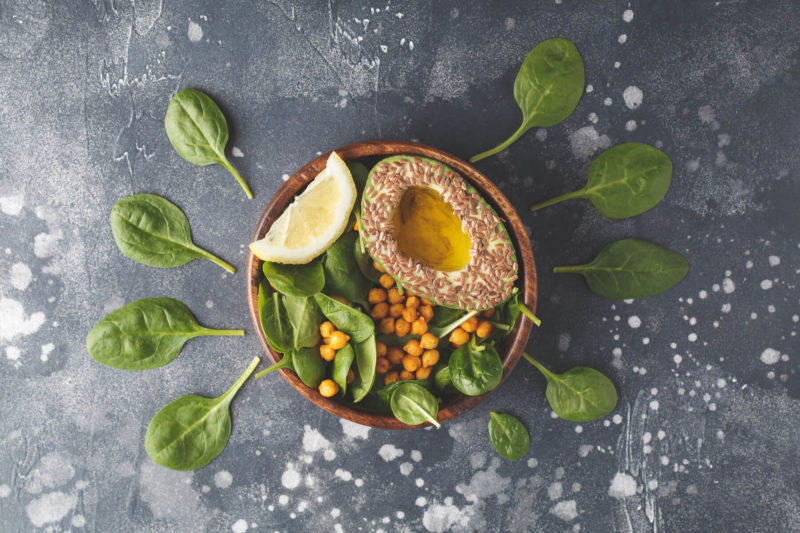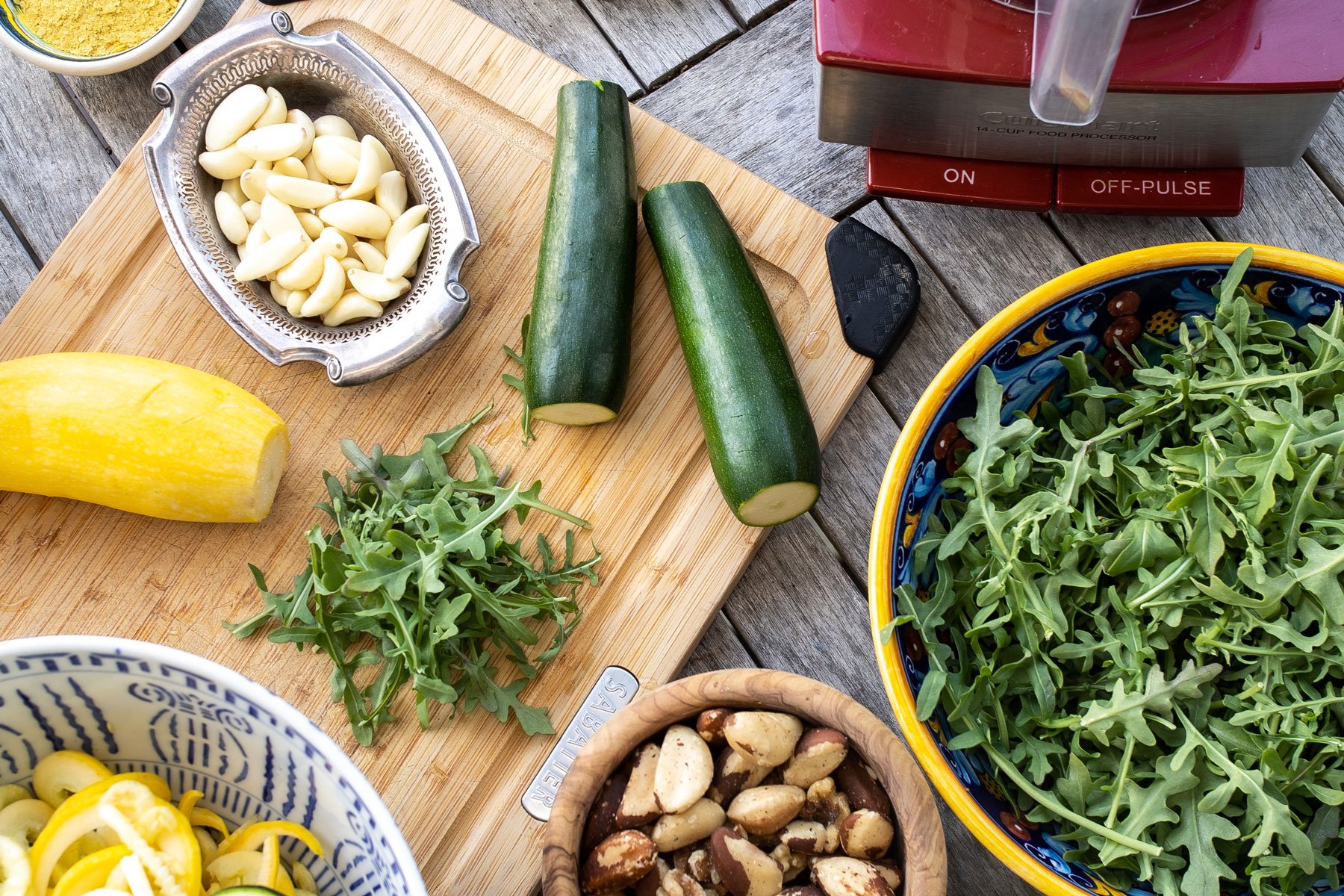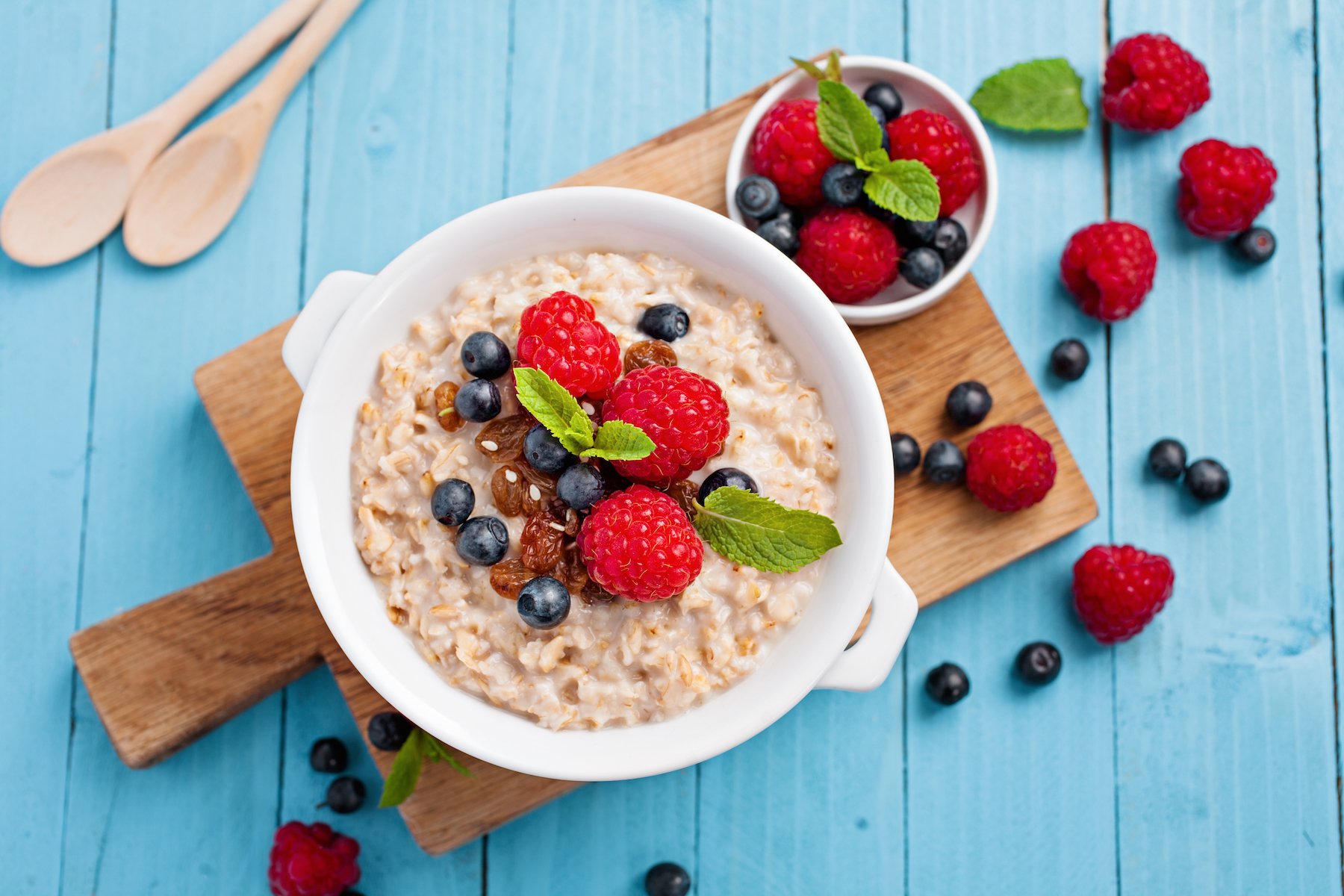Food is information for your cells. That’s why every food and beverage you consume can support or undermine how well your body functions. For instance, foods made with added sugars and refined grains often lack the nutrients your body needs to thrive at the cellular level and may cause spikes in blood sugar. These spikes can contribute to damaging oxidative stress and inflammation that can lead to insulin resistance and overall metabolic dysfunction.
Filling your diet with nutritious foods that keep blood sugar steady (think: fiber, quality protein, healthy fats) can reduce inflammation and oxidative stress and provide a range of micronutrients that can give your cells and metabolic processes the information they need to function optimally. So what exactly should you eat? Your best bet is to load up on whole or minimally processed veggies, fruits, legumes, nuts, and seeds, along with a few well-sourced animal-derived foods if you choose.
Here are 50 nutritious foods with a metabolic edge to inspire your next grocery list—and menu.
1. Almonds
Raw or sprouted almonds make an ultra-convenient travel snack or crunchy salad topper that delivers blood-sugar-stabilizing fiber and healthy monounsaturated fats, antioxidant vitamin E, and glucose-regulating magnesium. And try almond butter on celery or almond flour in baked goods as an alternative to wheat flour.
Tart, tangy, and mildly fruity apple cider vinegar (ACV) may improve insulin sensitivity and reduce post-meal increases in blood sugar. Use it in zesty homemade dressings and sauces; or, for maximum metabolic benefit, including glycemic control and improved blood lipid levels, mix a tablespoon of ACV in a cup of water and sip pre-meal.
3. Avocado
Avocados are full of inflammation-fighting monounsaturated fats (avocado oil is, too!) and deliver 10 g of fiber per fruit to support blood sugar balance, as well as heart and gut health. Use avocados to make guacamole, a creamy sauce for zoodles, or a mayo substitute.
4. Basil seeds
Tiny black basil seeds are rich in fiber and essential minerals that support glucose processing and energy production, such as magnesium, calcium, and iron. Like chia, they expand and form a gel when wet, making an excellent basil seed pudding. You can also add them to smoothies, soups, and salad dressings.
5. Beans
These “magical fruits” are inexpensive and a good source of gut-friendly fiber, protein, folate, magnesium, zinc, and polyphenol antioxidants. Add them to soups, veggie burgers, and burrito bowls (with cauliflower rice), along with a source of healthy fat like avocado to ensure stable blood sugar. (Note that some people see glucose spikes on beans.)
6. Beets
Beets are a good source of heart-healthy folate, blood-pressure-lowering dietary nitrates, and polyphenol antioxidants that help curb oxidative stress and inflammation. Use raw beets in a smoothie or toss them with extra virgin olive oil and roast. For gut-protective probiotics, pick up a pouch of beet sauerkraut.
7. Bell peppers
One yellow bell pepper contains more than 300% of the recommended daily allowance (RDA) for vitamin C, which functions as an antioxidant and helps regenerate other antioxidants in the body. Dip bell pepper slices in hummus, add to stir-fries, or use as a sandwich bread alternative.
8. Berries
Raspberries, blueberries, blackberries, and strawberries are low in sugar and relatively high in fiber (especially raspberries), so they’re unlikely to spike blood sugar. They’re also packed with polyphenol antioxidants called anthocyanins, which can help counteract the damage caused by oxidative stress. Pair berries with nuts for some protein, toss them in salads, or add them to plain yogurt.
9. Bok choy
Like other cruciferous greens, bok choy helps us produce sulfur compounds that optimize cellular pathways (like Nrf2 and NF-κB) that boost our antioxidant defenses and curb inflammation. Its subtly sweet cabbage-like flavor is delicious stir-fried, grilled, and in soups.
10. Broccoli
Broccoli contains the compound glucoraphanin, which stimulates the production of a beneficial sulfur compound called sulforaphane (it’s even higher in broccoli sprouts). Broccoli also contains fiber, vitamin C, folate, and manganese. Roast, steam, or stir-fry the florets, but don’t ditch the stalks! Use them in broccoli rice or this blender soup.
11. Brussels sprouts
Nearly half the carbs in these veggies come from fiber, making them a blood sugar-friendly choice. They’re also sky-high in vitamin C and contain the precursors to healthy sulfur compounds. Try them raw and shaved in a salad or roasted with olive oil and garlic.
12. Brazil nuts
Brazil nuts are brimming with selenium, a mineral that acts as an antioxidant, supports thyroid function and metabolism, and mimics insulin by improving cellular glucose uptake. Try them in trail mix, pestos, and salads, or just eat 1 to 2 per day to hit your selenium quota.
13. Capers
Capers are antioxidant-rich, and extracts from these immature flower buds have been shown to improve fasting blood sugar. Use capers to add a tangy, lemony, olive-like burst of flavor to salads, veggie bowls, deviled eggs, and soups—just a few go a long way.
14. Carrots
Subtly sweet carrots are an excellent source of beta-carotene (which becomes vitamin A in the body) and other carotenoids, which act as antioxidants to protect against oxidative stress. Use carrots to make a soup (adding ginger enhances their flavor), roast them with olive oil, or shred and add to slaws.
15. Cauliflower
Like broccoli, cauliflower contains the compounds that stimulate the production of sulforaphane, along with B vitamins that support glucose metabolism and vitamin C. Try it in fritters or use cauliflower as an ultra-low-carb sub for rice, pizza crust, or mashed potatoes.
16. Cashews
These nuts are rich in minerals such as zinc, which helps regulate insulin production, and magnesium, which promotes insulin sensitivity, so your body more efficiently processes glucose. Great as a snack, cashews are also delicious in stir-fries and blended into soups or creamy sauces.
17. Chia seeds
Chia seeds are packed with fiber and anti-inflammatory omega-3 fats, and they offer vital minerals needed for metabolic functioning—calcium, magnesium, iron, zinc, copper, manganese, and niacin. Sprinkle them on salads or stir-fries, or use them to make chia pudding.
18. Chickpeas
In addition to fiber, a cup of these inexpensive legumes is packed with metabolic-friendly minerals like manganese, which curbs oxidative stress in mitochondria (the energy-production centers of cells). Use them in salads, roast them to make a crunchy snack, or enjoy them as hummus. (Note that some people see glucose spikes from chickpeas.)
19. Cinnamon
Not only does this spice have a subtly sweet flavor, but it may also actually lower blood sugar. For example, a compound in cinnamon, MHCP, mimics insulin and helps cells absorb glucose from the blood and use as energy. Add a teaspoon to a smoothie or blend it into your coffee.
20. Cocoa powder
Cocoa is high in flavanols, a class of polyphenol antioxidants that may counteract inflammation and exert anti-diabetic properties by slowing glucose digestion and improving glucose uptake by muscle and liver tissue. Add cocoa to a smoothie, yogurt, or chia pudding for a satisfying chocolate taste with sugar.
21. Collard greens
Collards, another cruciferous veggie, offer sulfur compounds that promote antioxidants and reduce inflammatory pathways in the body. They’re also packed with vitamin K, which may curb metabolic syndrome risk. Use the broad, flat leaves with the earthy, pleasantly bitter taste to replace tortilla wraps and sandwich bread.
22. Cucumbers
Ultra hydrating and low in calories and carbs, cucumbers won’t spike blood sugar, and the peels pack a concentrated dose of phytochemicals (including polyphenols) with antioxidant properties. Cut them into rounds and top with tuna salad for a tasty lunch, use them to make a chilled soup with yogurt and dill, or eat with hummus or a nut-based dip for added protein.
23. Dark chocolate
Dark chocolate packs the same beneficial flavanols found in cocoa powder. Opt for bars with 85% cocoa or higher (like this Alter Eco bar), which are lower in sugar and contain a decent amount of fiber and iron.
24. Flaxseeds
Flaxseeds are rich in plant-based omega-3s, fiber, and lignans, which act as antioxidants and support hormone balance. Just one tablespoon daily may improve glycemic control. Blend whole flaxseeds into smoothies or soups for an extra thick, satisfying texture. Or roast them and sprinkle on salads or cooked veggies for some crunch.
25. Green beans
They contain just 31 calories and 7 g of carbs per cup, plus a good dose of fiber, vitamin C, and metabolic-friendly vitamin K. Saute green beans with garlic and olive oil for a tasty side, or add them to salads and stir-fries.
26. Green tea
Green tea contains the potent catechin antioxidant epigallocatechin-3-gallate (EGCG), and drinking it is associated with reduced Type 2 diabetes risk along with lower fasting glucose and HbA1c. Sip on hot green tea with some lemon, enjoy it iced with mint and honey, or add a teaspoon of matcha (powdered high-grade green tea) to your next smoothie.
27. Kale
Among dark leafy greens, kale has the highest levels of the carotenoid antioxidants beta-carotene and lutein, which protect against oxidative stress. It also offers vitamins C and K, and the precursors for helpful sulfur compounds. Add chopped kale to soups, bake it into chips, or turn it into pesto.
28. Kimchi
This tangy, spicy Korean dish typically made from fermented cabbage, contains fiber and natural probiotics. Eating it has been associated with improved insulin sensitivity and glucose tolerance and decreased blood pressure. Use it to give virtually any savory food a flavor boost—enjoy it with eggs, layer it on lettuce wraps, or sprinkle it into salads.
29. Lemons and limes
Citrus powerhouses, lemons and limes deliver big flavor for minimal sugar (just 1 to 2 g per fruit), along with vitamin C and flavonoids, which may help reduce inflammation. They’re incredibly versatile: Add their juice or zest to enhance and brighten beverages, sauces, smoothies, side dishes, and fish.
30. Lentils
Lentils are packed with fiber—you’ll get a third or more of your daily needs in just a half cup. Among the many perks of fiber, it feeds good gut bacteria, which helps curb inflammation and increase the production of metabolically beneficial short-chain fatty acids. Enjoy lentils in salads, soups, and curries.
31. Lettuce
This salad green contains beneficial carotenoid antioxidants, is ultra-low in carbs (most of which are fiber), and has a negligible impact on blood sugar. Toss lettuce with darker greens in salads, and ditch the bread and tortillas for romaine boats and Bibb lettuce wraps.
32. Mushrooms
Bursting with umami flavor, mushrooms are filled with beneficial compounds like polysaccharides—a type of carb known to help lower cholesterol and moderate gut bacteria, which can help reduce insulin resistance. Add them to salads and soups, sauté them with garlic for a tasty side, and make hybrid beef and mushroom burgers at your next cookout.
33. Olives
Olives are high in monounsaturated fats, which can improve cholesterol and insulin sensitivity. They’re also rich in polyphenols like hydroxytyrosol that fight oxidative stress and inflammation. Eat olives as a low-carb snack, and add them to salads and cauliflower crust pizza.
34. Onion
Aromatic allium vegetables like onions contain sulfur compounds that support the production of glutathione—a critical antioxidant that counters oxidative stress and aids detoxification. Add onions raw to salads and salsas or cooked in soups, sauces, and stir-fries.
35. Oranges
The moderate amount of sugar in oranges is offset by fiber, vitamin C, and citrus flavonoid compounds, which have been shown to improve glucose tolerance and modulate lipid metabolism, and reduce inflammation and oxidative stress. Add orange segments to salads, or make a citrusy salsa to top fish.
36. Pastured eggs
Eggs contain every vitamin (except vitamin C), as well as choline, which supports fat metabolism and liver function. Pastured eggs come from chickens that can forage in outdoor pastures and may contain twice the vitamin E and omega-3s as conventional. Whip up veggie-packed frittatas, hard-boil eggs and keep them in the fridge for a low-carb snack, or poach them in a spicy tomato sauce to make a shakshuka.
37. Pumpkin seeds
Pumpkin seeds, or pepitas, have fiber, protein, and lots of magnesium, a critical metabolic cofactor that may improve insulin sensitivity and the body’s ability to process glucose efficiently. Enjoy raw pumpkin seeds on yogurt, in trail mix, or in a pesto.
38. Salmon
A good source of lean protein, salmon is one of the rare natural sources of vitamin D and long-chain omega-3 fats, both of which have been shown to reduce inflammation and may protect against insulin resistance. Pan-fry filets with olive oil, or make salmon burgers with wild canned salmon.
39. Sardines
Like salmon, sardines are a great source of vitamin D and long-chain omega-3s. And when they are bought whole, they contain tiny bones, so they’re also rich in calcium, which is necessary for insulin secretion. Add wild canned sardines to salads, or mash and combine with a bit of cream cheese for a simple, nutritious dip.
40. Sauerkraut
Tart, tangy sauerkraut is made with sulfur-rich cabbage, which may positively influence antioxidant pathways and decrease inflammation in the body. As a fermented food, it can also support gut health. Add sauerkraut to salads, lettuce wraps, and eggs, or include it on a cheese board.
41. Seaweed
These ocean greens are low-carb, big in briny-umami flavor, and brimming with minerals like iodine, which is crucial for thyroid function, metabolism, and healthy weight. You can enjoy it in its different forms: Use nori sheets as a low-carb wrap, make seaweed salad with wakame, or sprinkle dulse flakes on eggs or pickled vegetables as seasoning.
42. Spinach
It’s a source of metabolically beneficial folate, iron, vitamin K, vitamin A (as beta-carotene), and other carotenoid antioxidants—and cooked spinach delivers a concentrated dose of all of them. Stock frozen spinach in your freezer to use in quick meals like frittatas, soups, and smoothies.
43. Tahini
Creamy tahini, made from sesame seeds, is a good source of minerals and phytochemicals called lignans, including sesamin, which functions as an antioxidant and may improve insulin sensitivity. Drizzle tahini over roasted veggies or stir-fries, use it in homemade salad dressings, or make hummus.
44. Tart or sour cherries
Tart cherries contain anthocyanin antioxidants that may help curb inflammation. They also appear to lower levels of uric acid, which has been implicated in metabolic syndrome and diabetes. Toss frozen tart cherries in a smoothie, or use them to make a vinaigrette to drizzle over salad, fish, or cooked veggies.
45. Tofu
A great source of complete protein that helps maintain stable blood sugar, tofu also has calcium for strong bones and proper insulin secretion. Use firm tofu to make a tofu breakfast scramble or tacos, or marinate it and add it to a plant-based stir-fry.
46. Tomatoes
They are rich in vitamin C, heart-healthy folate, and carotenoids such as lycopene, which may activate antioxidant pathways and support glutathione production. Use raw tomatoes in gazpacho or a Caprese salad, use them to make a chunky sauce, or roast them to boost lycopene’s bioavailability.
47. Turmeric
Turmeric is high in the phytochemical curcumin, which helps tame the inflammation and free radical damage that may contribute to metabolic dysfunction. Add it to grain salads, sprinkle it on eggs with black pepper (the pepper boosts curcumin’s absorption), or use it to make a golden milk latte.
48. Various herbs and spices
Herbs and spices—cinnamon, cloves, star anise, sage, rosemary, thyme, peppermint, celery seed, and others—offer a high concentration of polyphenols and other beneficial antioxidant compounds that counter oxidative stress. Use them to add flavor to every meal. Season your eggs, yogurt, salad dressings, dips, vegetable dishes, and lean protein with the herbs and spices of your choice.
49. Yogurt
Fermented foods, including yogurt, have been associated with improved gut microbial diversity and reduced inflammation, which are essential for metabolic health. Top plain, unsweetened Greek yogurt with berries and nuts for a dose of healthy fats, fiber, and phytochemicals, too.
50. Zucchini
Zucchini is a good source of antioxidant nutrients (vitamin C and carotenoids) and vitamin B6, which play a vital role in glucose metabolism. Make “zoodles” with a spiralizer, substitute it for pasta, and you’ll gain fiber and lose the empty carbs. Top with a spicy sauce, pesto, or a citrusy vinaigrette.








